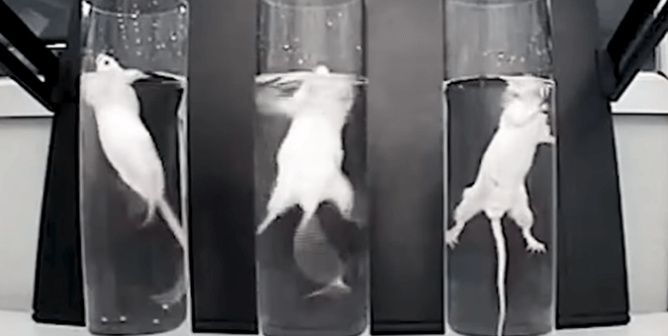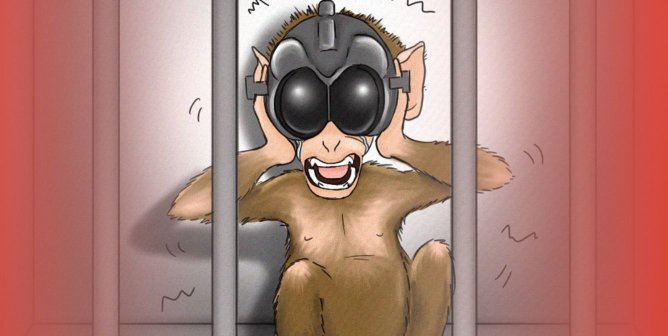The Military’s War on Animals
News reports tally the casualties of war, and monuments are erected to honor fallen soldiers, but the nonhuman victims of war—the animals who are shot, burned, poisoned, and otherwise tormented in military experiments and training exercises—are never recognized, nor is their suffering widely publicized.
Published experiments and internal documents obtained from the armed forces reveal that U.S. military agencies test all manner of weaponry on animals, from bombs to biological, chemical, and nuclear agents. Military experiments on animals can be painful, repetitive, costly, and unreliable.
Animals Killed for Military Training
For years, the U.S. Department of Defense (DOD) conducted so-called “wound labs,” during which conscious or semiconscious dogs and other animals were suspended from slings and shot with high-powered weapons to inflict injuries for crude medical training drills. In 1983, after PETA exposed and protested the Army’s plan to purchase dozens of dogs from animal shelters and shoot them on a firing range in Maryland, the military halted the program and permanently banned the use of dogs, cats, and primates in wound treatment experiments and training.1
However, the DOD and its contractors as well as companies working for the Department of Homeland Security continue to conduct highly secretive trauma training exercises (often referred to as “live tissue training”) in which thousands of other live animals—mainly pigs and goats—are maimed and killed each year.2 In a New York Times article, one service member described what happened to a pig during a trauma training exercise: “[Instructors] shot him twice in the face with a 9-millimeter pistol, and then six times with an AK-47 and then twice with a 12-gauge shotgun. And then he was set on fire. … I kept him alive for 15 hours.”3
In 2012, PETA released undercover video footage leaked by a whistleblower of a military trauma training course conducted by military contractor Tier 1 Group. In the video, course participants and instructors laugh and joke as live goats have their legs broken and amputated with tree trimmers, are stabbed, and have their internal organs pulled out.4 Anesthesia was inadequate, as indicated by the fact that some of the goats moan and kick during the mutilations. Following complaints filed by PETA, the U.S. Department of Agriculture cited and issued an official warning against Tier 1 Group for violating the federal Animal Welfare Act.5 For more on this case, please visit the PETA blog.
Non-Animal Methods Are Superior, Widely Used
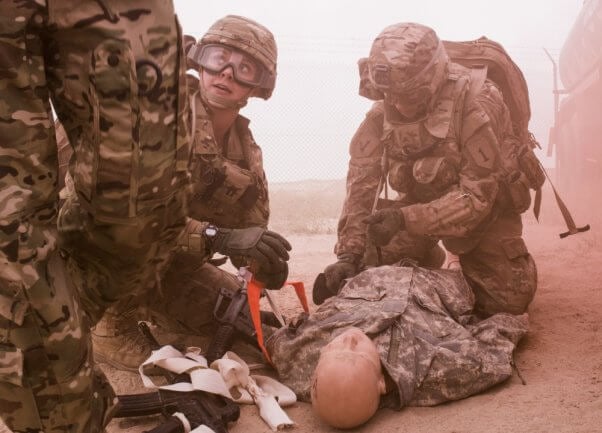
In 2012, PETA, along with current and former military doctors, published a study in the journal Military Medicine—the official journal of U.S. military surgeons—showing that nearly 80 percent of our NATO allies do not use any animals for military medical training.6 In an internal e-mail obtained by PETA, a top Army surgeon candidly admitted to colleagues that “there still is no evidence that [live tissue training on animals] saves lives.”7 Military regulations even require the use of “methods other than animal use” for training purposes when they are available, yet this policy is not being enforced.8
The military’s own research has shown the effectiveness of simulation technology for trauma training.9,10 Studies have repeatedly found that simulation-based trauma training is superior to crude drills on live animals both for teaching lifesaving medical skills and for improving trainee self-confidence.11-16 One study by military researchers explained that the use of animals for trauma training is problematic because of inherent limitations such as “differences in anatomy” and “lack of repeatable training.”17
The Army’s Rascon School of Combat Medicine at Fort Campbell does not use animals in its training program.18 The Air Force’s Center for Sustainment of Trauma and Readiness Skills and the Navy Trauma Training Center also do not use animals in medical training for service members.19,20
After complaints from PETA and German physicians, German authorities have repeatedly denied attempts by the U.S. Army to include maiming and killing animals in its training programs. According to news sources, German state government officials concluded that the procedures would “violate host nation animal protection laws” because “effective alternatives to animals are available.”21-23 In 2012, an expert panel of surgeons convened by a German court determined that animal use for military training was not justifiable, prompting a U.S. contractor to withdraw a lawsuit challenging a denial of its application to mutilate and kill animals.24
Animal Use Ended in Chemical Warfare Training
In 2011, PETA successfully campaigned to get the Army to stop poisoning monkeys in chemical attack training exercises and instead use advanced human-like simulators.25 PETA is currently working with Canadian military officials to end similar training drills that use live pigs.26
Animal Use Ended in Six Areas of Military Medical Training
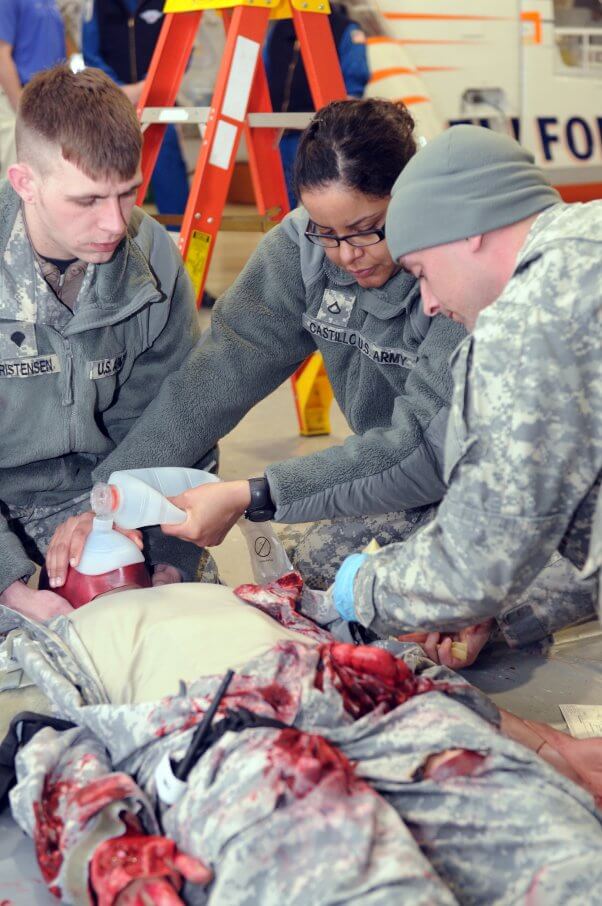
Over time, PETA has persuaded the Naval Medical Center San Diego,the Naval Medical Center Portsmouth, and the Madigan Healthcare System to stop forcing hard plastic tubes down cats’ and ferrets’ windpipes during pediatric intubation training, which can cause bleeding, swelling, pain, scarring, collapsed lungs, and even death.27-31 These facilities abandoned the animal laboratories in favor of humane simulation models, and all U.S. medical schools abandoned the practice as of 2016.32
In 2014, following an internal review regarding its use of animals in medical training, the Pentagon determined that “suitable simulation alternatives can replace the use of live animals” in six major medical educational areas—including in certain trauma and other surgical training courses and infant and pediatric life-support skills. The Pentagon also ordered all military branches “to fully transition to the use of simulations in these programs by no later than January 1, 2015.”33 Although it’s a groundbreaking reform, this policy continues to allow thousands of animals to be used and killed each year for combat trauma training and other military medical exercises.
Progress in Ending Animal Use in Military Trauma Training Drills
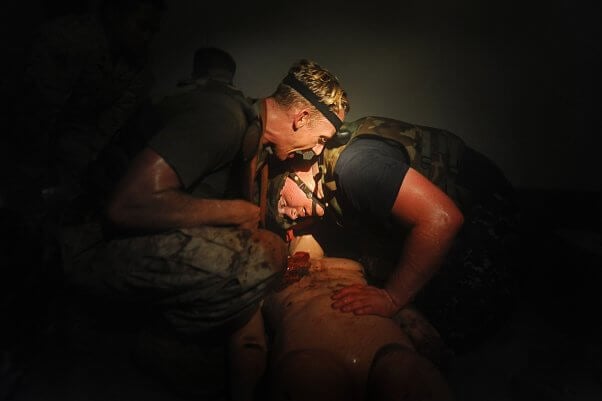
Congress passed the National Defense Authorization Act for Fiscal Year 2013, which contained a provision requiring the DOD for the first time ever to submit a report to Congress detailing a strategy and time frame for replacing animal use in military training drills with modern simulation and other humane methods.34 But what the DOD ultimately submitted was in defense of the use of animals, ignoring the demonstrated superiority of simulation methods and not providing a date by which it would stop using animals.
In 2017, the U.S. Coast Guard became the first branch of the military to suspend—and later end—the shooting, stabbing, and killing of animals in trauma training drills.35 The Coast Guard confirmed that the policy change went into effect after a PETA exposé prompted an official review by the agency.
The Defense Health Agency has reported that animal use in military trauma training is “outdated and cost-prohibitive”and “not anatomically accurate.”36,37 Bipartisan legislation, called the Battlefield Excellence through Superior Training (BEST) Practices Act (H.R. 1243/S. 498), has been introduced and, if enacted, would replace military trauma drills on animals with more effective human simulation models.38 This bill has garnered more than 100 bipartisan cosponsors in Congress, along with support from The New York Times editorial board as well as national medical and veterans organizations representing tens of thousands of physicians, doctors-in-training, and former service members.39
What You Can Do
Please help support our troops, improve medical training, and prevent thousands of animals from being killed each year in cruel trauma exercises. Urge your congressional representatives to support the BEST Practices Act, which would end the military’s use of animals in trauma training and mandate that troops be given access to high-tech human-patient simulators.
References
1Associated Press, “Reprieve From Wound Tests Is Ended for Pigs and Goats,” 24 Jan. 1984.
2Gary Martinic, “Military ‘Live Tissue Trauma Training’ Using Animals in The US – Its Purpose, Importance And Commentary on Military Medical research And The Debate on Use of Animals in Military Training,” Journal of Military and Veterans’ Health, 20 (2012): 4-14.
3C.J. Chivers, “Tending a Fallen Marine, With Skill, Prayer, and Fury,” The New York Times 2 Nov. 2006.
4Associated Press, “Coast Guard defends animal uses in medical training after alleged undercover PETA video,” 19 Apr. 2012.
5Joanne Kimberlin, “Military Contractor Cited for Treatment of Goats,” The Virginian-Pilot 30 June 2012.
6S.G. Gala et al., “Use of Animals by NATO Countries in Military Medical Training Exercises: An International Survey,” Military Medicine (2012) 177.8: 907–10.
7Scott Goodrich, internal U.S. Army Europe e-mail, 15 Sept. 2009.
8U.S. Department of Defense, “Use of Animals in DOD Programs,” instruction number 3216.01, Washington, D.C., 13 Sept. 2010.
9R.L. Mabry, “Use of a Hemorrhage Simulator to Train Military Medics,” Military Medicine (2005) 170.11: 921–5.
10C.M. Bowyer et al., “Validation of SimPL—A Simulator for Diagnostic Peritoneal Lavage Training,” Studies in Health Technology and Informatics (2005) 111: 64–7.
11E.F. Block et al., “Use of a Human Patient Simulator for the Advanced Trauma Life Support Course,” The American Surgeon 68.7 (2002): 648–51.
12A. Pandya et al., “The Role of TraumaMan in the Advanced Trauma Life Support Course,” Canadian Journal of Surgery (2009) 52 (Suppl.): S3–S19.
13R.A. Cherry et al., “Current Concepts in Simulation-Based Trauma Education,” Journal of Trauma (2008) 65.5: 1186–93.
14J. Ali et al., “Teaching Emergency Surgical Skills for Trauma Resuscitation–Mechanical Simulator Versus Animal Model,” ISRN Emergency Medicine (2012) Article ID 259864.
15I. Sergeev et al., “Training Modalities and Self-Confidence Building in Performance of Life-Saving Procedures,” Military Medicine (2012) 177.8: 901–6.
16G. Lin et al., “Rapid Preparation of Reserve Military Medical Teams Using Advanced Patient Simulators,” ITACCS (2003): 52.
17M. Ritter et al., “Simulation for Trauma and Combat Casualty Care,” Minimally Invasive Therapy & Allied Technologies 14.4-5 (2005): 224–34.
18Sarah Hogsed, “PETA: Live Goats Used in Fort Campbell Medic Training,” The Eagle Post, 20 Jan. 2010.
19U.S. Department of the Navy, “Statement on the Non Use of Live Animals for Training,” 19 Dec. 2008.
20U.S. Department of the Air Force, “Freedom of Information Act (FOIA) 08-0051-HS, C-STARS Courses,” 28 Aug. 2008.
21Nancy Montgomery, “Germany Again Shoots Down U.S. Army Europe’s Live-Tissue Training,” Stars and Stripes 28 Oct. 2010.
22John Vandiver and Marcus Kloeckner, “German Ruling Puts USAREUR Plans for Live-Animal Medical Training on Hold,” Stars and Stripes 17 Aug. 2010.
23Ben Knight, “US Medic Training on Live Pigs Faces Opposition,” The Local 18 Oct. 2011.
24Jean-Baptiste Piggin and Christian Schneider, “Germany Halts Plan to Shoot Live Pigs for Paramedic Training,” Stars and Stripes 2 Oct. 2012.
25Marissa Gallo, “PETA Claims Victory, Says Army Will End Monkey Testing at APG,” The Baltimore Sun 13 Oct. 2011.
26Randy Boswell, “Canadian Military ‘Actively’ Looking to End Animal Use in Medical Training,” Canada.com, 16 Aug. 2012.
27Naval Medical Center San Diego, letter to PETA, 13 Apr. 2011.
28Bill Sizemore, “Portsmouth Naval Medical Center to End Ferret Use,” The Virginian-Pilot 29 Mar. 2012.
29Brent Champaco, “PETA: Madigan Army Medical Center Has Stopped ‘Cruel’ Ferret-Testing,” Patch 15 Aug. 2013.
30C. Tait, “On the Differences Between a Child and a Kitten,” Journal of Emergency Nursing 36 (2010): 78‒80.
31A. Oshodi et al., “Airway Injury Resulting From Repeated Endotracheal Intubation: Possible Prevention Strategies” Pediatric Critical Care Medicine 12.1(2011): e34‒9.
32Associated Press, “Intubation Training on Cats Is Abandoned by US Medical Schools,” 17 Oct. 2016.
33Patricia Kime, “Defense Department To Reduce Use of Live Animals for Medical Training,” Military Times, 13 Nov. 2014.
34National Defense Authorization Act for Fiscal Year 2013, Pub. L. 112-239, 126 Stat. 1632 (2013).
35Hope Hodge Seck, “Ending ‘Abhorrent’ Live Tissue Training Was Right: Coast Guard,” Military.com, 18 May 2017.
36Defense Health Agency, “2016 Stakeholders Report,” Health.mil, accessed 21 Jan. 2019.
37Seed Funding Health Technologies, National SBIR Conference, 16 May 2017.
38BEST Practices Act, H.R. 1243, 115th Cong. (2017).
39New York Times Editorial Board, “Ban Animal Use in Military Medical Training,” 25 June 2016.



